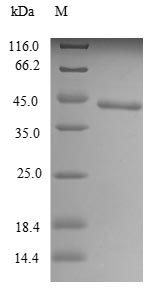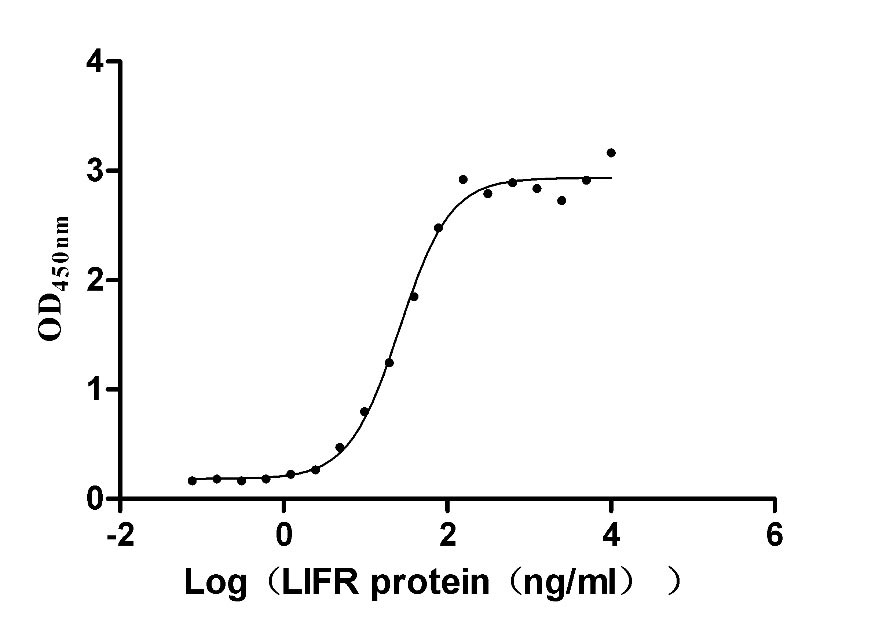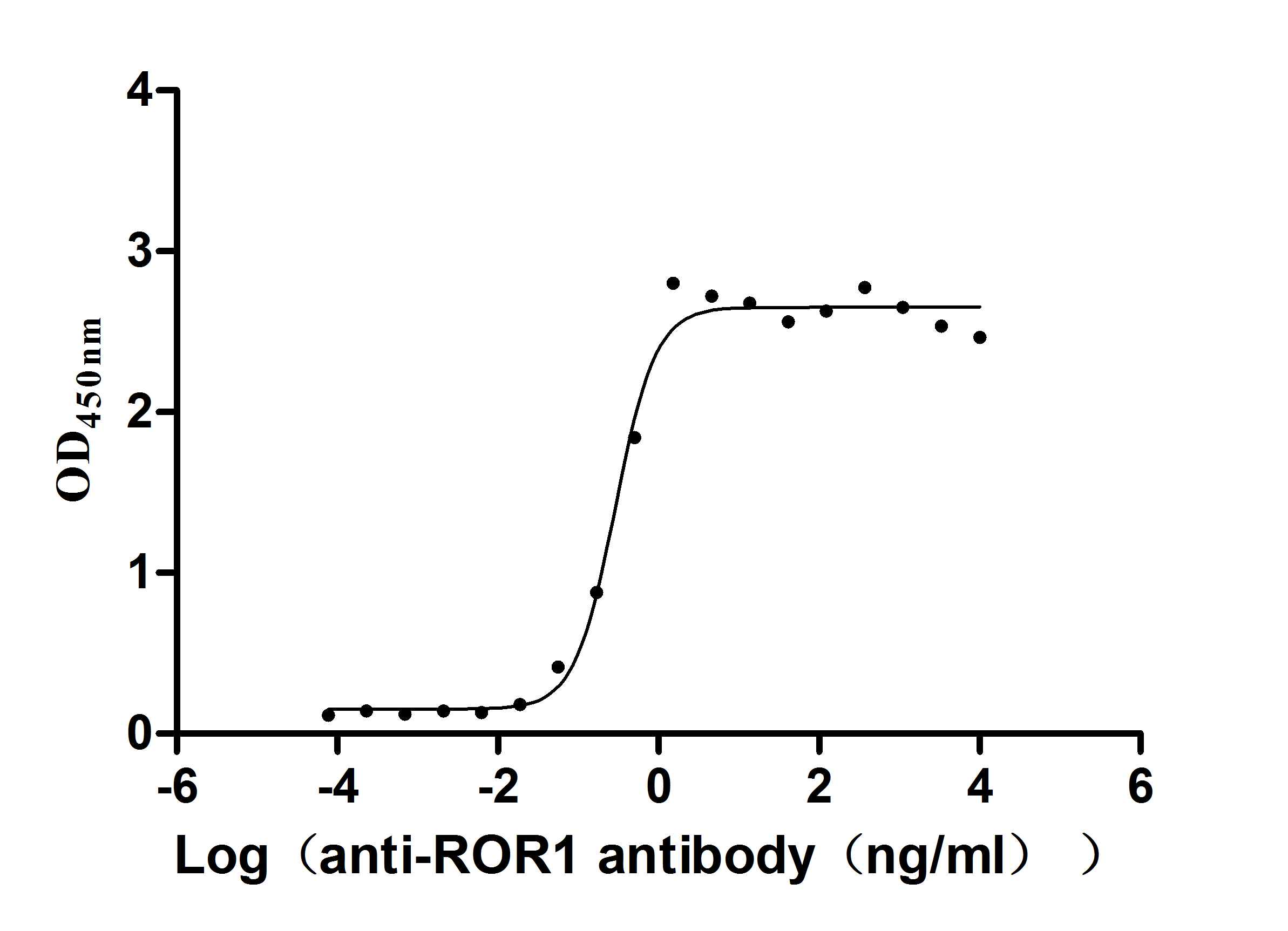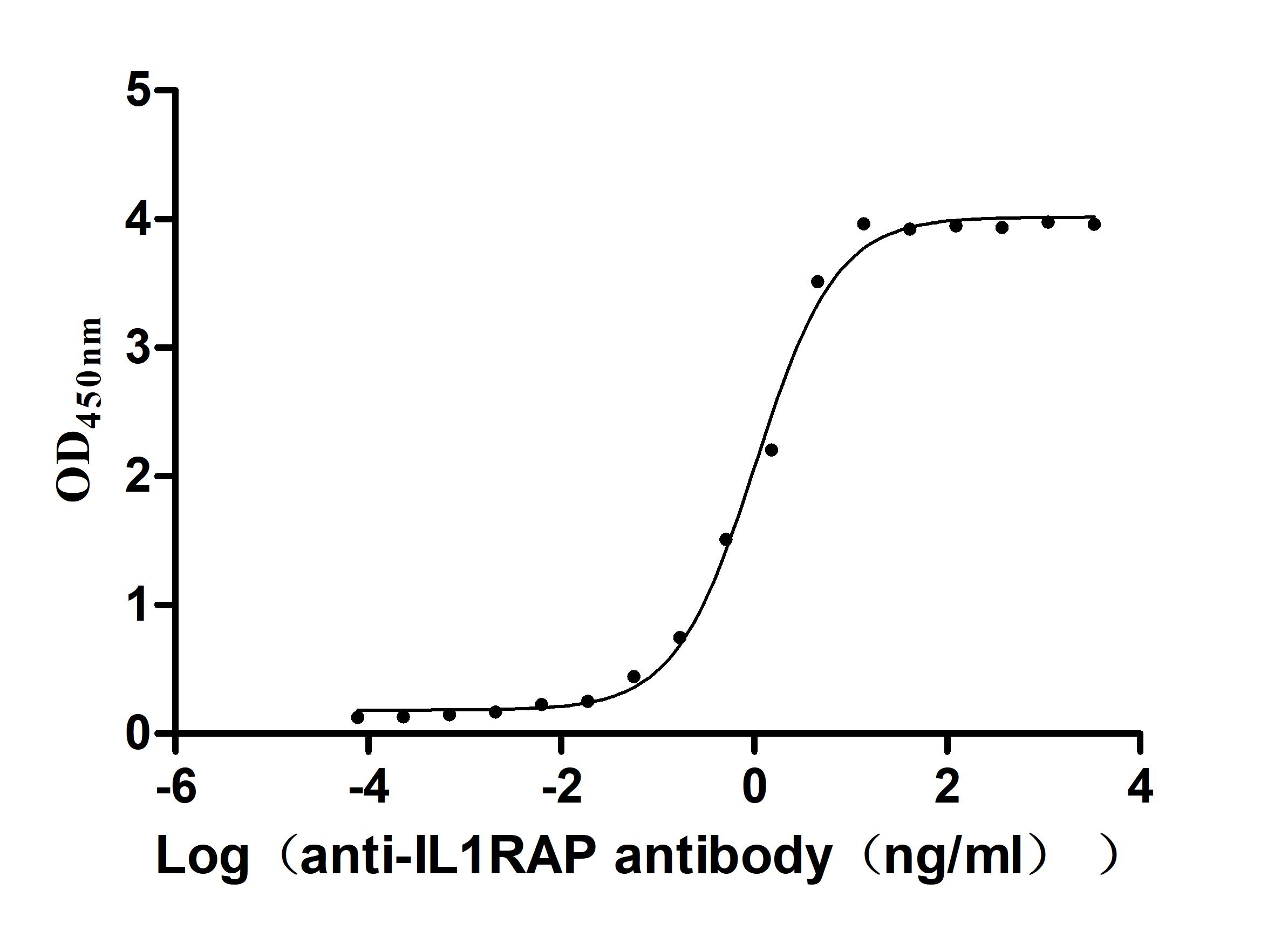Recombinant Mouse Toll-like receptor 7 (Tlr7), partial
In Stock-
货号:CSB-EP023606MOb1
-
规格:¥1836
-
图片:
-
其他:
产品详情
-
纯度:Greater than 85% as determined by SDS-PAGE.
-
基因名:
-
Uniprot No.:
-
别名:Tlr7; Toll-like receptor 7
-
种属:Mus musculus (Mouse)
-
蛋白长度:Partial
-
来源:E.coli
-
分子量:43.8 kDa
-
表达区域:27-348aa
-
氨基酸序列FRWFPKTLPCEVKVNIPEAHVIVDCTDKHLTEIPEGIPTNTTNLTLTINHIPSISPDSFRRLNHLEEIDLRCNCVPVLLGSKANVCTKRLQIRPGSFSGLSDLKALYLDGNQLLEIPQDLPSSLHLLSLEANNIFSITKENLTELVNIETLYLGQNCYYRNPCNVSYSIEKDAFLVMRNLKVLSLKDNNVTAVPTTLPPNLLELYLYNNIIKKIQENDFNNLNELQVLDLSGNCPRCYNVPYPCTPCENNSPLQIHDNAFNSLTELKVLRLHSNSLQHVPPTWFKNMRNLQELDLSQNYLAREIEEAKFLHFLPNLVELDFS
Note: The complete sequence including tag sequence, target protein sequence and linker sequence could be provided upon request. -
蛋白标签:N-terminal 10xHis-tagged and C-terminal Myc-tagged
-
产品提供形式:Liquid or Lyophilized powder
Note: We will preferentially ship the format that we have in stock, however, if you have any special requirement for the format, please remark your requirement when placing the order, we will prepare according to your demand. -
缓冲液:Tris-based buffer,50% glycerol
-
储存条件:Store at -20°C/-80°C upon receipt, aliquoting is necessary for mutiple use. Avoid repeated freeze-thaw cycles.
-
保质期:The shelf life is related to many factors, storage state, buffer ingredients, storage temperature and the stability of the protein itself.
Generally, the shelf life of liquid form is 6 months at -20°C/-80°C. The shelf life of lyophilized form is 12 months at -20°C/-80°C. -
货期:3-7 business days
-
注意事项:Repeated freezing and thawing is not recommended. Store working aliquots at 4°C for up to one week.
-
Datasheet & COA:Please contact us to get it.
相关产品
靶点详情
-
功能:Endosomal receptor that plays a key role in innate and adaptive immunity. Controls host immune response against pathogens through recognition of uridine-containing single strand RNAs (ssRNAs) of viral origin or guanosine analogs. Upon binding to agonists, undergoes dimerization that brings TIR domains from the two molecules into direct contact, leading to the recruitment of TIR-containing downstream adapter MYD88 through homotypic interaction. In turn, the Myddosome signaling complex is formed involving IRAK4, IRAK1, TRAF6, TRAF3 leading to activation of downstream transcription factors NF-kappa-B and IRF7 to induce proinflammatory cytokines and interferons, respectively.
-
基因功能参考文献:
- Results suggest that toll-like receptor 7 (TLR7) needs to move to the cell periphery to induce robust type I interferon responses in plasmacytoid dendritic cells (pDC). PMID: 29150602
- The results demonstrate that TLR7 activation may trigger innate immunity pathways and induce apoptosis and hypoplasia of neonatal biliary trees in Balb/c mice. The novel findings give an implication of pathogenesis of infantile cholestasis, such as biliary atresia. PMID: 27590984
- TLR7 deletion reduces atherosclerosis in apolipoprotein E-deficient mice. PMID: 28405010
- SZU-101 enhances tumor clearance in vivo, without affecting the TLR7-NF-kappaB pathway activated by the TLR7 agonist in mouse spleen lymphocytes and bone marrow dendritic cells PMID: 28000738
- Up-regulation of TLR7 could eliminate intracellular Mtb through autophagy PMID: 28419514
- conclude that VDD promotes tumor growth in the context of Smad3 disruption, potentially through regulation of TLR7 expression and beta-catenin activation PMID: 27456065
- activation of TLR7 in the mouse bladder induced cystitis with sensory hyperactivity of the bladder PMID: 28595240
- Here, we show that under these circumstances, the Toll-like receptor (TLR)-7/8 ligand imiquimod, but not the TLR3 ligand poly I:C or TLR9 ligand CpG, mediated an effective antitumor response. The rejection of these immune-escaped cancers was mediated by NK cells and CD4(+) T cells, whereas activated CD8(+) T cells were dispensable PMID: 28637878
- TLR7 prevents progression of non-alcoholic fatty liver disease via induced autophagy and released IGF-1 from liver. These findings suggest a new therapeutic strategy for the treatment of NAFLD. PMID: 27279075
- Toll-like receptor 2 (TLR2) controls random motility, while Toll-like receptor 7 (TLR7) regulates chemotaxis of microglial cells via distinct pathways. Furthermore, TLR7 mRNA expression is down-regulated by TLR2 and TLR7 activation. PMID: 27554518
- results provide evidence that G, dG, 8-OHG and 8-OHdG are novel endogenous ligands for TLR7. PMID: 26489884
- Virus infection activates endosomal NOX2 oxidase and restricts TLR7 signaling, and that an endosomal NOX2 inhibitor decreases viral pathogenicity. PMID: 28701733
- TLR7 deficiency attenuates retinal damage in diabetic retinopathy model. PMID: 28843858
- The data demonstrate that an atypical TLR7 signaling pathway contributes to type interferon-beta expression during Y. pestis infection and suggest that the TLR7-driven type I IFN response plays an important role in determining the outcome of plague. PMID: 28847850
- Evaluation of the adjuvant effect of agonists of toll-like receptor 4 and 7/8 in a vaccine against leishmaniasis PMID: 28963929
- these data demonstrate that extracellular-miRNA mimics (miR-34a, -122, -133a, -142, -146a, and -208a) are potent innate immune activators and that the miRNAs most likely induce cytokine production and leukocyte migration through TLR7 signaling PMID: 28768728
- study demonstrates that activation of TLR7 signaling in T cells can inhibit Th17 cell differentiation from naive T cells and IL-17 production in established Th17 cells; further report that downregulation of STAT3 signaling is responsible for TLR7-mediated inhibition of Th17 cells due to induction of suppressor of cytokine signaling 3 and 5 PMID: 28652396
- identification of a novel mechanism by which TLR and type I IFN synergize to promote monocyte/macrophage development from hematopoietic progenitors, a process critical in triggering rapid immune responses during infection PMID: 27566824
- Notch1-Hes-1 signaling controls TLR7-induced autophagic death of macrophage via regulation of P62 in mice with lupus. PMID: 27537524
- Dual TLR2/TLR7 agonist induced the maturation of dendritic cells and primed substantial populations of cytolytic and highly polyfunctional effector CD8(+) T cells in vitro, and safely potentiated the immunogenic properties of a nanoparticulate Ag in vivo, eliciting humoral responses with a balanced TH1/TH2 profile in mice. PMID: 28432147
- determine the effects of a loss of autophagy in dendritic cells (DCs), as well as both B cells and DCs, in a TLR7-mediated model of autoimmunity, similar to systemic lupus erythematosus, where both cell types are critical for disease PMID: 28031336
- findings show that TLR7 activation significantly promoted interphotoreceptor retinoid-binding protein (IRBP)-specific Th17 responses by upregulating RORgammat, IL-17, GM-CSF, and IL-23R expression in experimental autoimmune uveitis mice. PMID: 27798152
- CD72 appears to specifically inhibit B cell response to the endogenous TLR7 ligand Sm/RNP. PMID: 27810925
- TLR8 coupling with SOCS-1 inhibits TLR7-mediated antiviral immunity during WNV infection in mice. PMID: 27798161
- Azithromycin impairs imiquimod-induced dendritic cell activation by decreasing lysosomal acidification and disrupting TLR7 maturation and signaling. PMID: 27449383
- the activation of TLR7 increased CCND3 expression via the downregulation of miR-15b in B cells. PMID: 26144250
- this study demonstrates the critical role of Gfi1 in the regulation of myeloid cells, and prevention of spontaneous lupus autoimmunity by negatively controlling TLR7 signaling PMID: 27600904
- this study shows that beta,beta-dimethylacryloyl alkannin could inhibit psoriasis-activated dendritic cells via the TLR7/8 pathway PMID: 27697724
- Orally administered R848 triggers TLR-7 on CD11c(+) dendritic cells, inducing interleukin-23 (IL-23) expression followed by a burst of IL-22 secretion by innate lymphoid cells, leading to Reg3gamma expression and restoration of colonization resistance against vancomycin-resistant enterococcus. PMID: 26912904
- Aging Impairs the Ability of Conventional Dendritic Cells to Cross-Prime CD8+ T Cells upon Stimulation with a TLR7 Ligand. PMID: 26474053
- Type I Interferons maintain expression of TLR7 in B cells and conventional dendritic cells in different ways; total amount of TLR7 is kept in B cells and TLR7(+) population is retained among conventional dendritic cells. PMID: 26621862
- These data provide direct evidence that B cells require TLR7-dependent priming through an autophagy-dependent mechanism before autoimmunity is induced, thereafter involving many cell types. PMID: 26120731
- describe novel roles for type I IFN and TLR7 signaling in nonhematopoietic cells PMID: 26289159
- Data show that preconditioning with poly(I:C) alters toll-like receptors (TLR) and RIG-I-like receptors (RLRs) responses in opposite directions. PMID: 26392465
- Report chemical conjugation of TLR7 agonist T7 and multi-repeat-epitope of monoclonal gastric cancer 7 antigen exerts antitumor effects. PMID: 26185376
- Our data show that TLR7 excess influences the selection, expansion and diversification of B cells in the germinal center, independent of other genes in the Yaa locus. PMID: 25794167
- an important role of 2'-O-methylation for shaping differential TLR7 or TLR8 activation PMID: 25785446
- Cardiac RNA induces inflammatory responses in cardiomyocytes and immune cells via MyD88-TLR7 signaling. PMID: 26363072
- B-cell intrinsic TLR7 signals promote depletion of the marginal zone in a murine model of Wiskott-Aldrich syndrome. PMID: 26256668
- A mucolipin agonist specifically enhanced TLR7 responses to ssRNAs. PMID: 25239130
- These studies identify that TLR7 stimulation leads to the expansion of IL-10-producing CD19(+) CD1d(hi) B cells, which can suppress allergic lung inflammation via T regulatory cells. PMID: 25763771
- Treatment with Let7c and miR21 restricted dendritic growth of wild-type neurons but not Tlr7(-/-) neurons PMID: 25917529
- activation exacerbated lupus nephritis through dendritic and t-regulatory cells PMID: 25341693
- TLR8 deletion accelerated autoimmunity in lupus-prone mice in response to TLR7 activation. PMID: 25424423
- Inhibition of IDO could enhance the therapeutic efficacy of TLR7 agonists via the increase of T helper type 1 immune response in tumors. PMID: 25322876
- Study demonstrates for the first time that influenza A virus and TLR7 activation enhance the NOX2 oxidase-dependent oxidative burst in macrophages. PMID: 24869957
- This work identifies signalling through TLR7 as a source of pathology in experimental cerebral malaria. PMID: 25192715
- Results suggest that the TLR7 response following Japanese encephalitis virus infection promotes type-1 interferon production and generation of antiviral state which might contribute to protective effect in systemic infection PMID: 24909816
- A single copy of TLR7 in B cells is the minimal requirement for breaking the germinal center-tolerance checkpoint. PMID: 25252960
- TLR7 activation led to myd88-dependent production of pro-inflammatory cytokines in dystrophin-deficient muscle cells. PMID: 24368419
显示更多
收起更多
-
亚细胞定位:Endosome membrane. Endoplasmic reticulum membrane; Single-pass type I membrane protein. Lysosome. Cytoplasmic vesicle, phagosome. Note=Relocalizes from endoplasmic reticulum to endosome and lysosome upon stimulation with agonist.
-
蛋白家族:Toll-like receptor family
-
数据库链接:
KEGG: mmu:170743
STRING: 10090.ENSMUSP00000061853
UniGene: Mm.23979
Most popular with customers
-
Recombinant Human Leukemia inhibitory factor (LIF) (Active)
Express system: Mammalian cell
Species: Homo sapiens (Human)
-
Express system: Mammalian cell
Species: Homo sapiens (Human)
-
Recombinant Human Claudin-6 (CLDN6)-VLPs, Fluorescent (Active)
Express system: Mammalian cell
Species: Homo sapiens (Human)
-
Recombinant Macaca fascicularis Membrane spanning 4-domains A1 (MS4A1)-VLPs (Active)
Express system: Mammalian cell
Species: Macaca fascicularis (Crab-eating macaque) (Cynomolgus monkey)
-
Recombinant Human C-C chemokine receptor type 6(CCR6)-VLPs (Active)
Express system: Mammalian cell
Species: Homo sapiens (Human)
-
Recombinant Human Interleukin-12 receptor subunit beta-1(IL12RB1),partial (Active)
Express system: Mammalian cell
Species: Homo sapiens (Human)
-
Recombinant Macaca fascicularis Interleukin 1 receptor accessory protein(IL1RAP), partial (Active)
Express system: Mammalian cell
Species: Macaca fascicularis (Crab-eating macaque) (Cynomolgus monkey)





f4-AC1.jpg)














